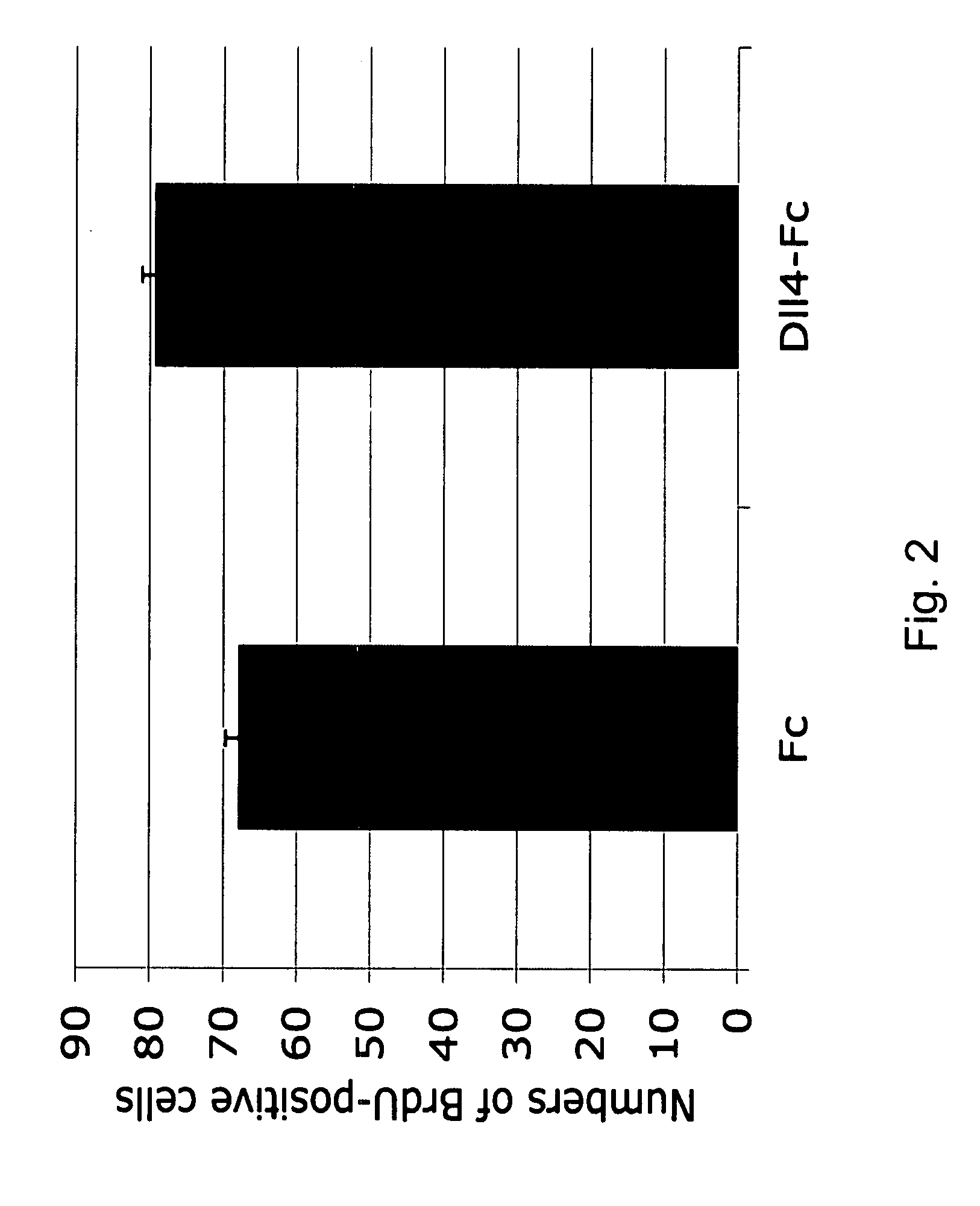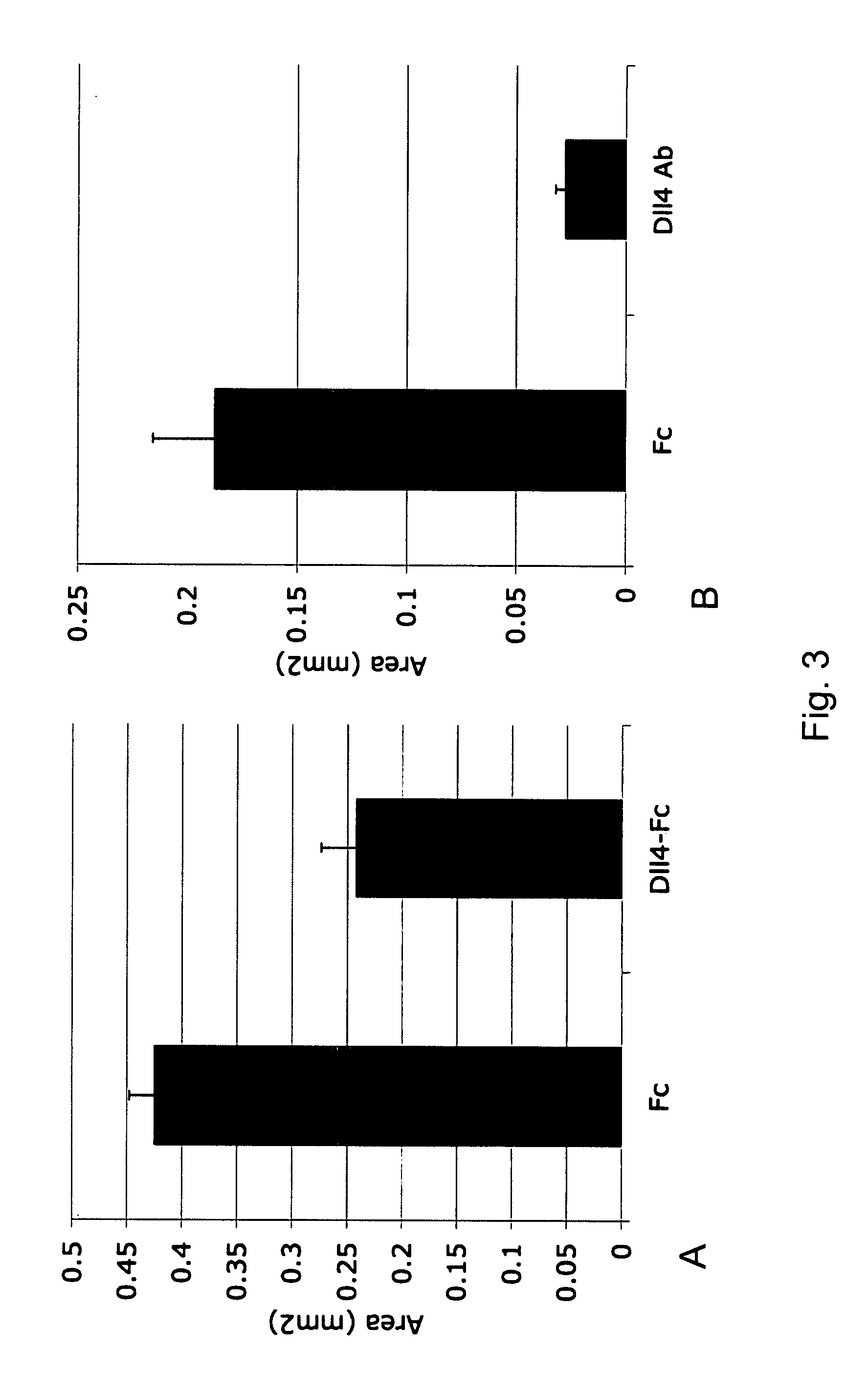Therapeutic methods for treating vascular eye disorders with DII4 antagonists
a technology of dii4 and vascular eye disorders, applied in the field of therapeutic methods for treating vascular eye disorders with dii4 antagonists, can solve the problems of insufficient angiogenesis, insufficient blood vessel occlusion, and serious medical problems, and achieve the effects of enhancing tissue perfusion, enhancing normal regrowth, and suppressing pathological changes
- Summary
- Abstract
- Description
- Claims
- Application Information
AI Technical Summary
Benefits of technology
Problems solved by technology
Method used
Image
Examples
example 1
Effect of Genetic Deletion of a Single Dll4 Allele on Blood Vessel Sprouting in the Developing Retinal Vasculature
[0047]An investigation was undertaken to determine the effects of Dll4 partial genetic deficiency on blood vessel sprouting during normal developmental retinal angiogenesis.
[0048]Animals. Velocigene™ technology (Valenzuela et al. (2003) Nat. Biotechnol. 21:652-9; U.S. Pat. No. 6,586,251, which references are specifically incorporated by reference in their entirety) was used to replace the entire Dll4 coding region with the β-galactosidase reporter gene in C57BL / 6:129 hybrid mouse embryonic stem cells. Chimeric males were bred to ICR females. Dll4+ / lacZ mice backcrossed for 3 generations to ICR (87.5% ICR) were used for this study.
[0049]Histochemistry and Immunostaining. Mouse pups were humanely euthanized at P7. Eyes were enucleated, and retinas were dissected, fixed overnight with 4% paraformaldehyde, stained with FITC-labeled Griffonia simplicifolia (GS) lectin I (Vect...
example 2
Effect of Dll4 / Notch Inhibition with Dll4-Fc or Anti-Dll4 Antibody on the Developing Retinal Vasculature
[0052]An investigation was undertaken to determine the effects of Dll4 / Notch signaling pharmacological inhibition on endothelial cell proliferation and blood vessel sprouting during normal developmental retinal angiogenesis.
[0053]Antibodies and reagents. Dll4-Fc comprises the extracellular domain of mouse or human Dll4 and the Fc part of human IgG. Dll4-Fc was expressed in CHO cells and affinity purified by protein-A chromatography. Anti-Dll4 antibody was produced by immunization of rabbits with recombinant mDll4-hFc. The anti-serum was partially purified by protein-A chromatography prior to use.
[0054]Animals. C57 / B16 mice (Taconic) were used to study the effect of Dll4-Fc or neutralizing Dll4 antibody on developing retinal vasculature.
[0055]Intravitreal microiniections. Intravitreal microinjections (30-100 nl) of the research compounds were made between the equator and the cornea...
example 3
Effect of Dll4-Fc and Anti-Dll4 Antibody on Retinal Vascularization, Perfusion and Vascular Abnormalities in Mice with OIR
[0059]An investigation was undertaken to determine the effects of the Dll4-Fc and anti-Dll4 antibody on the growth of retinal vessel, formation of vascular abnormalities and retinal perfusion in oxygen-induced ischemic retinopathy (OIR).
[0060]To determine whether Dll4 / Notch signaling plays a role in pathologic angiogenesis as well as during normal development, the OIR model was utilized. In the OIR model, exposure of mouse pups to hyperoxia at P7 results in a rapid obliteration of capillaries in the central retina. Following return to room air at P12, the avascular zone becomes severely hypoxic, which in turn elicits extensive abnormal neovascularization, characterized by the ectopic growth of vessels into the vitreous (epiretinal vascular ‘tufts’) and the formation of abnormal arteriovenous shunts; central parts of the retina remain largely avascular for an exte...
PUM
| Property | Measurement | Unit |
|---|---|---|
| Therapeutic | aaaaa | aaaaa |
Abstract
Description
Claims
Application Information
 Login to View More
Login to View More - R&D
- Intellectual Property
- Life Sciences
- Materials
- Tech Scout
- Unparalleled Data Quality
- Higher Quality Content
- 60% Fewer Hallucinations
Browse by: Latest US Patents, China's latest patents, Technical Efficacy Thesaurus, Application Domain, Technology Topic, Popular Technical Reports.
© 2025 PatSnap. All rights reserved.Legal|Privacy policy|Modern Slavery Act Transparency Statement|Sitemap|About US| Contact US: help@patsnap.com



